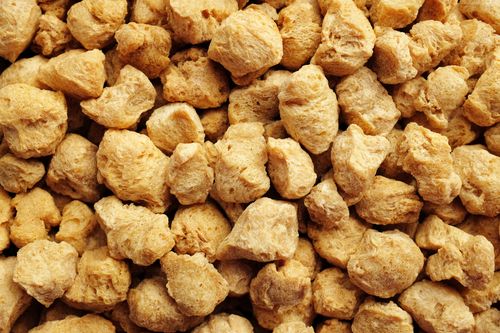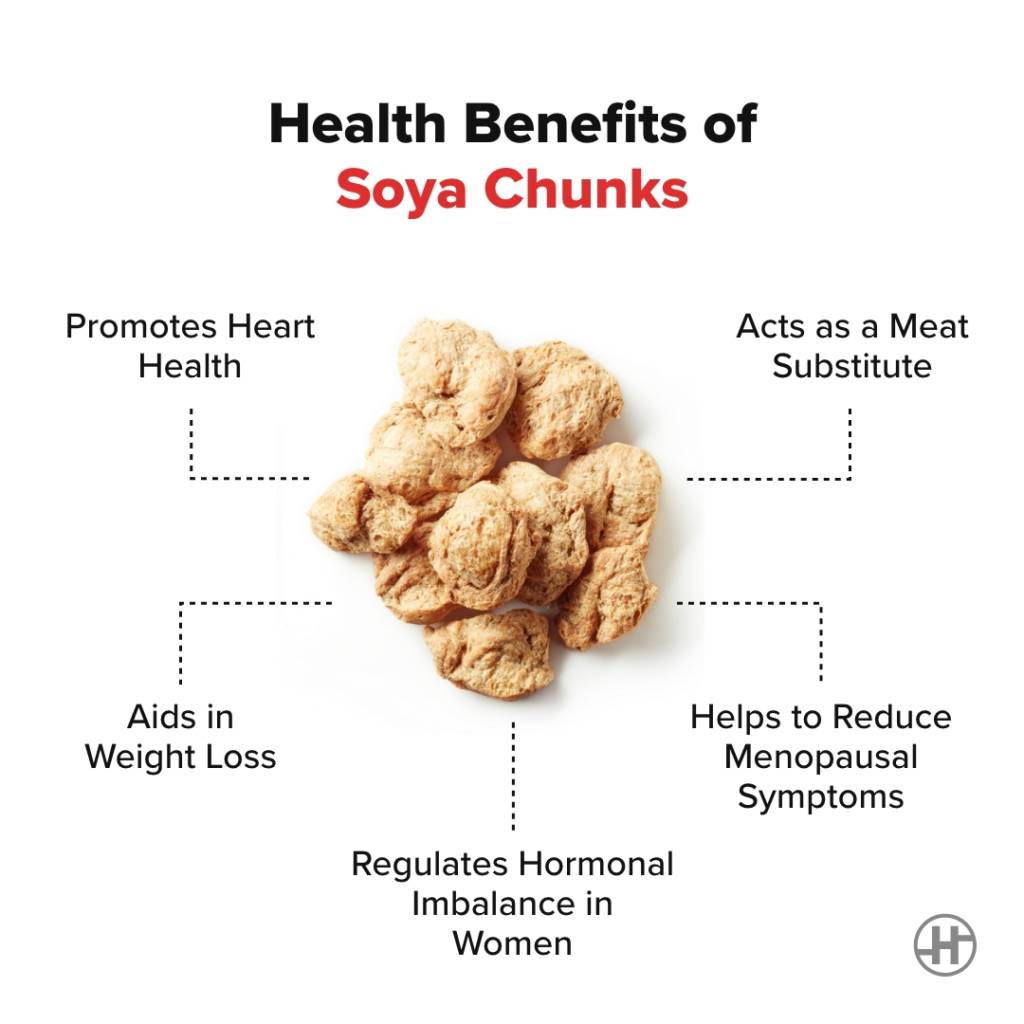Soya Chunks – Nutritional Facts, Benefits and Recipe

Parul Dube
May 6, 2025

Parul Dube
May 6, 2025
With more people turning to vegetarianism, veganism and plant-based diets, and a renewed interest in high-protein diets, soya chunks are popular among vegetarians for their high protein content. Apart from vegetarians, soya chunks are popular among non-vegetarians too, for their meat-like density and texture.
The high protein content in soya chunks makes it very popular, especially among the fitness conscious crowd.
Soya chunks first became popular in Eastern parts of India. Then, even the non-vegetarians started buying soya chunks and started using them as a substitute for meat. The love for soya chunks caught on in other parts of India gradually.
However, there are conflicting views regarding how much soya chunks are good for health. First, a few years back, specific popular diets focused on what soya was deficient in, giving it a bad rap. Like all other good things, one should consume soy in moderation too.
Imagine getting all the goodness of meat without its downsides. Soya chunks are Textured Vegetable Protein (TVP) or Textured Soy Protein (TSP). Extraction of beans gives soybean oil. The residue or the by-product that is left behind is called soy flour.
Incidentally, this flour led to the formation of soya chunks. Since all the oil is removed, the flour is defatted. So, soya chunks are ideally fat-free.
Another advantage of soya chunks is their neutral taste. A classic pulao with soya chunks must be familiar to most. They blend well with all cuisines, making it easy to adapt to the cooking style.
Although soya chunks come in their dehydrated form, they double their volume quickly. The texture of soya chunks becomes soft, fibrous, and spongy once you soak it in water.
The protein in soya chunks is on par with real meat. Moreover, they are low in fat and are pocket friendly. Hence, they get their name as ‘vegetarian’s meat’.
The Soya Production and Research Association (SPRA) debuted soya chunks or TVP in the fall of 1972. The founder, Knister, Robert W. Nave, was raised in India and had a deep interest in the welfare of low-income people. Initially, SPRA sold soya chunks at low prices and in affordable packaging. But the product did not receive a warm welcome.
SPRA began to market soya chunks as a premium product with improved packaging. They were only sold in specific stores and targeted the upper-income group. Once the Sikh community made soya chunks a common ingredient in their weddings, the product’s success was inevitable.
The nutritional values can vary depending on the brand, and method prescribed to cook. For example, a famous soya chunk brand in India has the following nutrient profile.
100 gram of soya chunks has:

Vegetarians and those who suffer from protein deficiency can incorporate soya chunks into their diet. They help to make up for the recommended value of protein without tampering with one’s traditions.
Each 100 gram serving has 345 calories with 52 grams of protein. It indeed qualifies as an alternative to meat, yet provides extra protein as compared to chicken and lamb.

Soya chunks are rich in protein, omega3 fatty acids, fibre and low in saturated fat.
Also, a 2015 study published in the Molecules journal talks about the benefits of soya and its ability to lower the levels of bad cholesterol in the body. Thus, in addition, good cholesterol prevents several heart ailments, making soya chunks a heart-friendly food.
This unique plant based protein is known to reduce body weight and fat mass. The fibre content in soya chunks keeps hunger at bay. In addition, they can keep you full for long hours.
Soya chunks have a greater thermogenic effect (energy needed above the basal metabolic rate to digest, absorb and metabolize food) than carbohydrates. Thus, when taken in correct proportions, soya chunks can aid in your weight loss journey.
Many women going through the menopause phase have hot flashes, night sweats, trouble sleeping, vaginal dryness, and mood swings. Dozens of small studies have looked at the effects of soy on these symptoms, especially hot flashes.
Soy chucks are rich in isoflavones, it’s a type of phytoestrogen. These are believed to work like estrogen and thus ease out symptoms of menopause.
Due to phytoestrogens in soya chunks, women with irregular hormonal activity can eat soya chunks regularly.
In particular, postmenopausal women and those suffering from PCOS benefit the most. It imitates estrogen and regulates the menstrual cycle in women.

Both animal and human studies have shown that consumption of soy foods can increase the levels of bifidobacteria and lactobacilli in the gut, thus enhancing gut health.
Consumption of soy foods has been shown to have beneficial effects on multiple aspects of human health, including reduced risk of inflammation-related diseases, such as cardiovascular disease, diabetes, and certain cancers.
A study by The Department of Nutritional Sciences of the Oklahoma State University, explains the efficacy of soy protein in relieving pain and inflammation in osteoarthritis.
Soybean can be extremely beneficial for diabetics and should definitely be added to their diet.
A study from the University of Massachusetts Amherst found that soybean is rich in bioactive compounds known as isoflavones. These compounds are responsible for lowering the risk of diabetes and heart diseases. More importantly, the study noted that consuming soy-based foods can lead to a decrease in blood sugar levels and even improve tolerance of glucose in those who have been diagnosed with diabetes.
Soya chunks are a fantastic substitute for meat in almost all non-vegetarian dishes. From biryani to pasta, you can use them in a variety of cuisines as well. Here are two simple recipes to get you started with soya chunks.

Pulao is one of the easiest dishes that use soya chunks. Pair it with the soya Manchurian given below for a perfect main course.
The presence of phytoestrogens in soya chunks is a reason for debate. Although this property is highly beneficial for women with hormonal imbalance, it may be unnecessary for others.
Consuming high amounts of soya chunks may cause hormonal issues in men as well. They also have the potential to increase uric acid in the body, leading to some health problems. However, these effects are valid only when one consumes soy chunks in large quantities.
Therefore, stick to a maximum of 25 to 30 gram of soya chunks per day and rejoice in their benefits.
A. Soya chunks are rich in protein and fibre. However, avoid consuming soy chunks in excess quantity. The presence of phytoestrogens can be harmful in some instances. It may lead to health problems like hormonal imbalance, thyroid imbalance, and higher uric acid levels in the body. The recommended serving of soy chunks is around 15- 25 grams per day.
A. Boil water in a pan and add the dehydrated soy chunks to it. Cook for about 5 to 6 minutes or until the soya chunks become spongy and enlarged. Next, run cold water over the cooked soya chunks to rinse them well. Lastly, squeeze out any excess water before adding to gravies and rice. Many brands come with an instruction manual on the back of the cover. Read them first for a better understanding.
A. Yes, soya chunks, when taken in correct quantities, can be beneficial for men too. Phytoestrogens which are naturally present in plants, have a similar function to the human hormone estrogen. So, some theories say that consuming large amounts of it may cause a hormonal imbalance in men. As a precaution, do not exceed the recommended serving per day.
A. For easy recipes, you can add soya chunks to salads, pulao and fried rice. Replace meat with soya chunks in any dish for a vegetarian option. A simple curry made with soy chunks tastes excellent too. Since they do not have any particular taste, you can add them to a variety of dishes.
A. No, soya chunks have very low-fat content. Soya chunks can help in weight loss. The high fibre food tends to keep you fuller for extended periods. Therefore, soya chunks do not have fattening properties inherently. However, if consumed in large amounts, they may exceed your daily calorie intake. When this practice continues for long periods, it may lead to weight gain.
A. Soya Chunks have great protein content and are full of polyunsaturated fats, along with omega-3 fatty acids. It is packed with numerous nutritional benefits like; it is good for cardiovascular health, skin, hair and even bone. So, soya chunks can be a healthy option to include in your diet.
A. Overeating soya can cause problems like bloating, nausea, constipation and an increase in the frequency of urination. To avoid having these symptoms, limit your consumption to one serving (25g) per day.
A study from the University of Massachusetts Amherst explains about bioactive compounds known as isoflavones in soya and how it is beneficial for lowering the risk of diabetes.


I’m 47 , go regularly to gym , how much amount of Soya chunks should I consume daily ?
Dose soya chunk good for hypothyroidism
does soya chunks loose their protein content when boiled or soaked in hot water?
When you soak soya chunks in water they absorb water and expand. While some amount of water-soluble vitamins like Vit B and C may get lost, the protein content stays intact.
You still have to take your thyroid supplement if your thyroid is less active. Soy food will not replace your medication!
Rightly so, yes, once you start taking your thyroid medication, it is for life and cannot be replaced by soy food. Some research findings have shown that soy food interferes with the body’s ability to absorb the medication- synthetic thyroid hormone. However, more evidence is needed to determine if soy food needs to be completely eliminated from the diets of those having hypothyroidism.
Is the 15-25g a measure of dry soya or cooked soya?
Should be dry am asuming
50 gm raw soya chunks have around 26 gm of protein. Doesn’t the protein content reduce due to boiling or cooking the soya chunks? How to retain the entire protein content of soya chunks?
What happens if we eat soya chunks daily?
Hello Sanjay, Measure your quantity before deciding to eat soya chunks daily. Excessive consumption of soya increases uric acid in the body, it also can contribute to water retention and weight gain.
soya chunks benefits for skin?
Hello Sudha Rao, Soy offers plenty of skin benefits like it improves skin texture, makes skin look radiant, eliminates hyperpigmentation, protects against sun damage, etc.
Can soya chunks increase weight?
Hello Swaroop, Consult your nutritionist before you add soya chunks to your weight gain diet plan. A well-monitored addition of soya chunks is beneficial to help in increasing weight.
How much soybean per day is safe?
Hello Sunitha, If you rely on soya chunks as a plant based protein, you can have a quantity of 15-25 gram of soya chunks per day.
Can I eat soya chunks everyday?
Hello Pooja, You can have soya chunks every day to fulfil your protein requirement. However, check your quantity as it should not increase more than 15- 25gram per day or if you have hypothyroidism. Excessive intake of soya chunks can increase the level of uric acid in your body and damage your liver.
Is soya chunks good for male?
Hello Karthik, It has been observed that including soy based food in the diets of men diagnosed with prostate cancer displayed significant improvements in their PSA (Prostate-specific antigen) levels. Soya chunks is good to reduce LDL cholesterol.